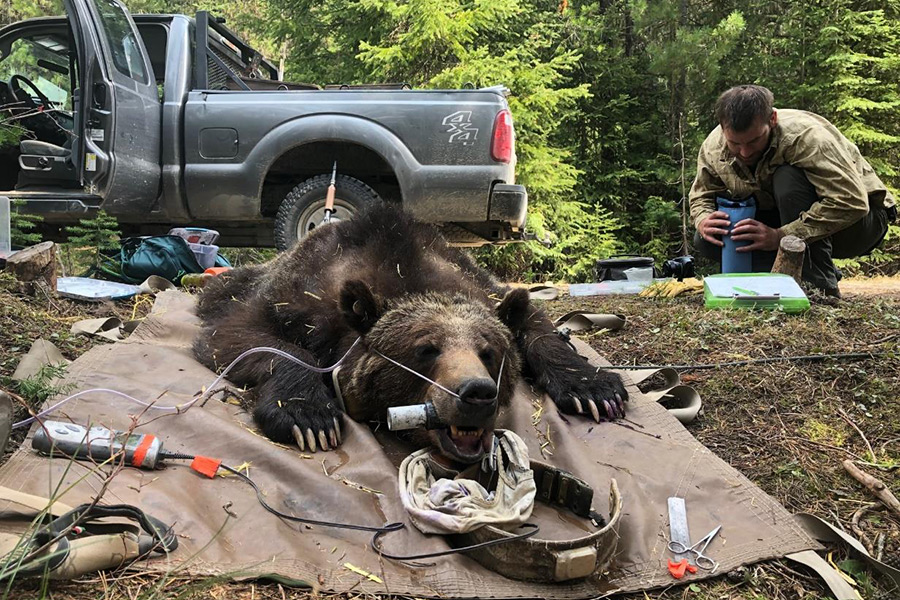Bullock Appoints Members to Grizzly Bear Advisory Council
Grizzlies in the Lower 48 are federally protected as a threatened species, but their management would revert to state control if those protections are lifted
By Beacon Staff
Montana Gov. Steve Bullock announced the 18 members of the state’s new Grizzly Bear Advisory Council, with several members selected from Northwest Montana.
Bullock announced in March that he would establish the council in an effort to help initiate and steer a statewide discussion about the conservation, recovery and future management of the species.
“I’m grateful for the incredibly strong interest from Montanans across the state who offered to serve on this council, speaking both to the timeliness of this discussion and the passion for grizzly bears that Montanans share,” Bullock said in a press release. “I look forward to this diverse council working together to find balanced ways to conserve bears and meet the needs of Montanans and our state.”
Members from Northwest Montana include Chuck Roady, the vice president and general manager for F.H. Stoltze Land and Lumber in Columbia Falls; Anne Schuschke, a substitute teacher and expedition leader for Natural Habitat Adventures in East Glacier; Gregory Schock, the owner of Schock’s Mission View Dairy in St. Ignatius; and Kristen Lime, a rancher and pre-college advisor for Montana Educational Talent Search in Browning.
“This council can play a critical role in providing timely and durable solutions to bear management and conservation that work for Montana in the long-term,” Bullock said.
Bullock solicited applications for council membership beginning in April, seeking “individuals with a diversity of views and commitment to working together on the future of grizzly bears in Montana,” according to the governor’s press release. More than 150 people from across the state applied, and Bullock worked in consultation with Montana Fish, Wildlife and Parks (FWP) before making his final selections.
Bullock appointed the council to “reflect the diverse group of people who have a connection to grizzly bears, including those who live, work, and recreate in bear country.”
“The council is intentionally representative of the different parts of the state where grizzlies are currently or may soon be found,” the governor’s office said.
Grizzlies in the Lower 48 are federally protected as a threatened species, but their management would revert to state control if those protections are lifted.
Currently, the U.S. Fish and Wildlife Service (USFWS), in cooperation with FWP, the U.S. Forest Service, National Park Service, Bureau of Land Management, the Blackfeet Tribe and Confederated Salish and Kootenai Tribes, all manage grizzly bears in Montana as “threatened” under authority of the Endangered Species Act.
A critical part of the recovery strategy crafted by the USFWS established six distinct recovery zones in Montana, Wyoming, Idaho, and Washington.
The largest recovery zone in terms of distinct population segments of grizzlies is the Northern Continental Divide Ecosystem, a sprawling region situated in Northwest Montana that includes Glacier National Park and portions of two Indian reservations, five national forests and four wilderness areas, and is home to an estimated 1,000 bears. The Greater Yellowstone Ecosystem in Montana, Wyoming and Idaho around Yellowstone National Park has an estimated 750 grizzlies.
USFWS has attempted to delist grizzly bears in the Greater Yellowstone Ecosystem and may still delist them in the Northern Continental Divide Ecosystem. Whether listed or not, it is expected that grizzly populations will continue to grow and expand, and that conflicts and management challenges will continue to increase.
As established by an executive order from the governor, the advisory council’s work will focus on: maintaining and enhancing human safety; ensuring a healthy and sustainable grizzly bear population; improving timely and effective response to conflicts involving grizzly bears; engaging all partners in grizzly-related outreach and conflict prevention; and improving intergovernmental, interagency, and tribal coordination.
In Montana, FWP is responsible for much of the day-to-day management of bears. Bullock has asked FWP to provide support to the council and will be “making space for all key partners with a role in bear management to be closely involved with the group’s work.”
Bullock’s press release said FWP intends to include many opportunities to provide input and to inform the council’s deliberations.
“I want to thank the Governor for his leadership in putting this statewide advisory council together,” FWP Director Martha Williams said in a statement. “It is one more demonstration of how Montana is taking the initiative and looking at what it means to both conserve grizzly bears and recognize an increasing number of bears on the landscape impacts people and their livelihoods.”
“This advisory council is another way to listen and learn from the people of Montana about how we might best manage bears and conserve them into the future,” she added.